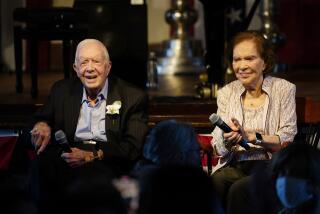Dr. William Lamers Jr. dies at 80; championed modern hospice care
“I’m not sick; I’m only dying,” a friend told Dr. William Lamers Jr. The man had inoperable cancer and wanted to go home to die, but his doctor wouldn’t let him out of the hospital.
It was the early 1970s, when most people with incurable illnesses died in a hospital, in a lonely room, attended by doctors and nurses with no specialized knowledge of the dying patient’s emotional and physical needs. There was no system for caring for the dying at home.
The experience opened Lamers’ eyes to a major failing of the healthcare system.
In 1974 Lamers, a psychiatrist, helped start one of the first hospice programs in the United States, Hospice of Marin in Northern California. It helped terminally ill patients spend their last days at home, surrounded by family and supported by health workers and volunteers trained in end-of-life care.
Considered one of the founders of the modern hospice movement in the United States, Lamers died Feb. 2 in Malibu of an infection, his family said. He was 80.
The approach he championed spread across the country. There are now more than 5,000 hospice programs in the U.S., according to the National Hospice and Palliative Care Organization. Unlike in England, where the modern hospice movement began, the majority of U.S. hospices provide care in patients’ homes rather than in a separate facility.
“In many ways the growth of hospice in this country is a direct result of Bill Lamers’ work and the model he created,” said Ken Doka, senior consultant to the Hospice Foundation of America. Lamers “really moved the notion of hospice from a facility to one’s home.”
When his friend with cancer was dying, Lamers was unfamiliar with the word “hospice” but knew from his psychiatry practice that providing a “good” death was crucial — not only to the patient but also to the survivors. He once estimated that at least one-third of his patients had issues that stemmed from unresolved grief.
At first he considered opening a counseling center to help people deal with loss. His focus changed after he met Elisabeth Kubler-Ross, the Swiss-born psychiatrist whose 1969 bestseller “On Death and Dying” lifted the taboo in the medical community on discussions of dying. She encouraged Lamers to start a hospice and introduced him to the work of Cicely Saunders, who in 1968 had established the first modern hospice, St. Christopher’s in London.
Saunders’ concept was to provide home-like comforts for the dying in a facility devoted to their care. Although impressed with Saunders’ pioneering efforts, Lamers didn’t want to raise money for a building. He thought there was no better home-like environment “than one’s own home,” Doka said.
With Rev. John Thornton, an Episcopal priest, and social worker Barbara Hill, Lamers started Hospice of Marin out of his house in San Rafael. Now called Hospice by the Bay, it serves four Northern California counties.
One of Lamers’ earliest cases was a woman from the Midwest with terminal cancer who was new in town and had no friends or family. She wanted to die at home with her dog. Lamers and the hospice staff asked her neighbors to help her and promised to show them how.
“They gave her beautiful care, as good as she could have received in our best hospitals,” Lamers told the Marin Independent Journal in 1979. “When she died, all the people who had helped gathered together. They weren’t strangers anymore; they were like a family. And they said ... when can we do something like this again?”
“What Bill was really interested in was building community,” said Sandol Stoddard, author of “The Hospice Movement” (1978), who observed Lamers’ early efforts in Marin. “He was a joyous person who loved people and loved his work.”
His spirit was not his only bountiful feature. Thornton recalled a time someone mistook part of Lamers’ ample physique for a backpack: Lamers, clad in snow gear, said, “That’s not a backpack, that’s me!”
Born in Milwaukee on Christmas Eve in 1931, Lamers graduated from Marquette University School of Medicine in 1958. After an internship in San Francisco, he completed his residency in general psychiatry and a National Institute of Mental Health fellowship in child psychiatry in Cincinnati.
In the mid-1960s, after serving in the Navy, he moved to Kentfield in Marin County, where he opened a private practice in child and family psychiatry.
He was believed to be one of the first physicians to prescribe lithium to treat bipolar disease. He was also an early advocate of oral morphine to manage chronically severe pain, according to Stephen R. Connor of the Worldwide Palliative Care Alliance.
Lamers served as Hospice of Marin’s president until 1976 and medical director until 1981. He later was the medical director at hospices in Los Angeles and Calabasas. He also trained scores of hospice managers and was chairman of a national hospice accreditation panel.
In the course of his work, he witnessed hundreds of deaths over the decades. One case he often mentioned was that of a boy with bone cancer whose mother asked him on his final morning what he wanted for breakfast. The boy replied, “A kiss.”
“You can’t top that,” Lamers had recalled.
Lamers is survived by his wife, Elizabeth; a daughter, Jennifer; two sons, William III and Mark; stepdaughters Sabrina De Fillipis and Monique Sofen; two brothers and seven grandchildren.
He died at home under hospice care, with family and friends by his side.
More to Read
Start your day right
Sign up for Essential California for the L.A. Times biggest news, features and recommendations in your inbox six days a week.
You may occasionally receive promotional content from the Los Angeles Times.







